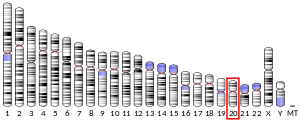HM13
Minor histocompatibility antigen H13 is a protein that in humans is encoded by the HM13 gene.[5][6][7]
Function
The minor histocompatibility antigen 13 is a nonamer peptide that originates from a protein encoded by the H13 gene.[8][9] The peptide is generated by the cytosol by the proteasome, enters the endoplasmic reticulum (ER) lumen by the transporter associated with antigen processing (TAP) and is presented on the cell surface on H2-Db major histocompatibility antigen I (MHC I) molecules. The alloreactivity, which leads to transplant rejection in mice, is conferred by Val/Ile polymorphism in the ‘SSV(V/I)GVWYL’ peptide.[10] The orthologue gene in humans is called HM13. If a related polymorphism exists, and if the HM13 serves as a Minor histocompatibility antigen, however, remains to be addressed.
The protein encoded by the M13/HM13 gene is the signal peptide peptidase (SPP), an ER-resident intramembrane protease.[5] SPP localizes to the endoplasmic reticulum, catalyzes intramembrane proteolysis of some signal peptides after they have been cleaved from a preprotein. This activity is required to generate signal sequence-derived human lymphocyte antigen-E epitopes that are recognized by the immune system, and to process hepatitis C virus core protein. The encoded protein is an integral membrane protein with sequence motifs characteristic of the presenilin-type aspartic proteases. Multiple transcript variants encoding several different isoforms have been found for this gene.[7]
References
- GRCh38: Ensembl release 89: ENSG00000101294 - Ensembl, May 2017
- GRCm38: Ensembl release 89: ENSMUSG00000019188 - Ensembl, May 2017
- "Human PubMed Reference:". National Center for Biotechnology Information, U.S. National Library of Medicine.
- "Mouse PubMed Reference:". National Center for Biotechnology Information, U.S. National Library of Medicine.
- Weihofen A, Binns K, Lemberg MK, Ashman K, Martoglio B (Jun 2002). "Identification of signal peptide peptidase, a presenilin-type aspartic protease". Science. 296 (5576): 2215–8. doi:10.1126/science.1070925. PMID 12077416.
- Nyborg AC, Kornilova AY, Jansen K, Ladd TB, Wolfe MS, Golde TE (Apr 2004). "Signal peptide peptidase forms a homodimer that is labeled by an active site-directed gamma-secretase inhibitor". J Biol Chem. 279 (15): 15153–60. doi:10.1074/jbc.M309305200. PMID 14704149.
- "Entrez Gene: HM13 histocompatibility (minor) 13".
- "Entrez Gene: H13 histocompatibility (minor) 13".
- Snell GD, Cudkowicz G, Bunker HP (Jun 1967). "Histocompatibility genes of mice. VII. H-13, a new histocompatibility locus in the fifth linkage group". Transplantation. 5 (3): 492–503. doi:10.1097/00007890-196705000-00011. PMID 5340356.
- Mendoza LM, Paz P, Zuberi A, Christianson G, Roopenian D, Shastri N (Oct 1997). "Minors held by majors: the H13 minor histocompatibility locus defined as a peptide/MHC class I complex". Immunity. 7 (4): 461–72. doi:10.1016/S1074-7613(00)80368-4. PMID 9354467.
Further reading
- Lemberg MK, Bland FA, Weihofen A, et al. (2002). "Intramembrane proteolysis of signal peptides: an essential step in the generation of HLA-E epitopes". J. Immunol. 167 (11): 6441–6. doi:10.4049/jimmunol.167.11.6441. PMID 11714810.
- Deloukas P, Matthews LH, Ashurst J, et al. (2002). "The DNA sequence and comparative analysis of human chromosome 20". Nature. 414 (6866): 865–71. doi:10.1038/414865a. PMID 11780052.
- Grigorenko AP, Moliaka YK, Korovaitseva GI, Rogaev EI (2002). "Novel class of polytopic proteins with domains associated with putative protease activity". Biochemistry Mosc. 67 (7): 826–35. doi:10.1023/A:1016365227942. PMID 12139484.
- McLauchlan J, Lemberg MK, Hope G, Martoglio B (2002). "Intramembrane proteolysis promotes trafficking of hepatitis C virus core protein to lipid droplets". EMBO J. 21 (15): 3980–8. doi:10.1093/emboj/cdf414. PMC 126158. PMID 12145199.
- Lemberg MK, Martoglio B (2002). "Requirements for signal peptide peptidase-catalyzed intramembrane proteolysis". Mol. Cell. 10 (4): 735–44. doi:10.1016/S1097-2765(02)00655-X. PMID 12419218.
- Strausberg RL, Feingold EA, Grouse LH, et al. (2003). "Generation and initial analysis of more than 15,000 full-length human and mouse cDNA sequences". Proc. Natl. Acad. Sci. U.S.A. 99 (26): 16899–903. doi:10.1073/pnas.242603899. PMC 139241. PMID 12477932.
- Urny J, Hermans-Borgmeyer I, Gercken G, Schaller HC (2004). "Expression of the presenilin-like signal peptide peptidase (SPP) in mouse adult brain and during development". Gene Expr. Patterns. 3 (5): 685–91. doi:10.1016/S1567-133X(03)00094-2. PMID 12972007.
- Lehner B, Semple JI, Brown SE, et al. (2004). "Analysis of a high-throughput yeast two-hybrid system and its use to predict the function of intracellular proteins encoded within the human MHC class III region". Genomics. 83 (1): 153–67. doi:10.1016/S0888-7543(03)00235-0. PMID 14667819.
- Ota T, Suzuki Y, Nishikawa T, et al. (2004). "Complete sequencing and characterization of 21,243 full-length human cDNAs". Nat. Genet. 36 (1): 40–5. doi:10.1038/ng1285. PMID 14702039.
- Moliaka YK, Grigorenko A, Madera D, Rogaev EI (2004). "Impas 1 possesses endoproteolytic activity against multipass membrane protein substrate cleaving the presenilin 1 holoprotein". FEBS Lett. 557 (1–3): 185–92. doi:10.1016/S0014-5793(03)01489-3. PMID 14741365.
- Soares MR, Bisch PM, Campos de Carvalho AC, et al. (2004). "Correlation between conformation and antibody binding: NMR structure of cross-reactive peptides from T. cruzi, human and L. braziliensis". FEBS Lett. 560 (1–3): 134–40. doi:10.1016/S0014-5793(04)00088-2. PMID 14988012.
- Friedmann E, Lemberg MK, Weihofen A, et al. (2005). "Consensus analysis of signal peptide peptidase and homologous human aspartic proteases reveals opposite topology of catalytic domains compared with presenilins". J. Biol. Chem. 279 (49): 50790–8. doi:10.1074/jbc.M407898200. PMID 15385547.
- Gerhard DS, Wagner L, Feingold EA, et al. (2004). "The Status, Quality, and Expansion of the NIH Full-Length cDNA Project: The Mammalian Gene Collection (MGC)". Genome Res. 14 (10B): 2121–7. doi:10.1101/gr.2596504. PMC 528928. PMID 15489334.
- Otsuki T, Ota T, Nishikawa T, et al. (2007). "Signal sequence and keyword trap in silico for selection of full-length human cDNAs encoding secretion or membrane proteins from oligo-capped cDNA libraries". DNA Res. 12 (2): 117–26. doi:10.1093/dnares/12.2.117. PMID 16303743.
- Urny J, Hermans-Borgmeyer I, Schaller HC (2006). "Cell-surface expression of a new splice variant of the mouse signal peptide peptidase". Biochim. Biophys. Acta. 1759 (3–4): 159–65. doi:10.1016/j.bbaexp.2006.02.007. PMID 16730383.
- Loureiro J, Lilley BN, Spooner E, et al. (2006). "Signal peptide peptidase is required for dislocation from the endoplasmic reticulum". Nature. 441 (7095): 894–7. doi:10.1038/nature04830. PMID 16738546.
- Sato T, Nyborg AC, Iwata N, et al. (2006). "Signal peptide peptidase: biochemical properties and modulation by nonsteroidal antiinflammatory drugs". Biochemistry. 45 (28): 8649–56. doi:10.1021/bi060597g. PMID 16834339.



